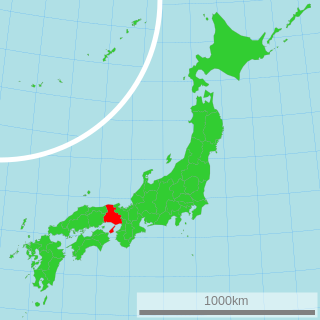
Hyōgo Prefecture is a prefecture of Japan located in the Kansai region of Honshu. Hyōgo Prefecture has a population of 5,469,762 and has a geographic area of 8,400 square kilometres (3,200 sq mi). Hyōgo Prefecture borders Kyoto Prefecture to the east, Osaka Prefecture to the southeast, and Okayama Prefecture and Tottori Prefecture to the west.

Himeji is a city located in Hyōgo Prefecture in the Kansai region of Japan. As of May 1, 2016, the city has an estimated population of 534,881, with 213,950 households and a population density of 1,000.84 persons per km2. The total area is 534.43 km2 (206.34 sq mi).

The Japanese dry garden or Japanese rock garden, often called a zen garden, is a distinctive style of Japanese garden. It creates a miniature stylized landscape through carefully composed arrangements of rocks, water features, moss, pruned trees and bushes, and uses gravel or sand that is raked to represent ripples in water. A zen garden is usually relatively small, surrounded by a wall or buildings, and is usually meant to be seen while seated from a single viewpoint outside the garden, such as the porch of the hojo, the residence of the chief monk of the temple or monastery. Many, with gravel rather than grass, are only stepped into for maintenance. Classical zen gardens were created at temples of Zen Buddhism in Kyoto during the Muromachi period. They were intended to imitate the essence of nature, not its actual appearance, and to serve as an aid to meditation about the true meaning of existence.

One Tree Hill is a town on the outskirts of Adelaide, South Australia. It is located in the City of Playford.

The City of Port Adelaide Enfield, located across inner north and north-western suburbs of Adelaide, is one of the largest metropolitan councils within South Australia. It was established on 26 March 1996 by the amalgamation of the City of Port Adelaide and the City of Enfield.

Japanese gardens are traditional gardens whose designs are accompanied by Japanese aesthetics and philosophical ideas, avoid artificial ornamentation, and highlight the natural landscape. Plants and worn, aged materials are generally used by Japanese garden designers to suggest a natural landscape, and to express the fragility of existence as well as time's unstoppable advance. Ancient Japanese art inspired past garden designers. Water is an important feature of many gardens, as are rocks and often gravel. Despite there being many attractive Japanese flowering plants, herbacious flowers generally play much less of a role in Japanese gardens than in the West, though seasonally flowering shrubs and trees are important, all the more dramatic because of the contrast with the usual predominant green. Evergreen plants are "the bones of the garden" in Japan. Though a natural-seeming appearance is the aim, Japanese gardeners often shape their plants, including trees, with great rigour.

The River Torrens, is the most significant river of the Adelaide Plains. It was one of the main reasons for the siting of the city of Adelaide, capital of South Australia. It flows 85 kilometres (53 mi) from its source in the Adelaide Hills near Mount Pleasant, across the Adelaide Plains, past the city centre and empties into Gulf St Vincent between Henley Beach South and West Beach. The upper stretches of the river and the reservoirs in its watershed supply a significant part of the city's water supply.
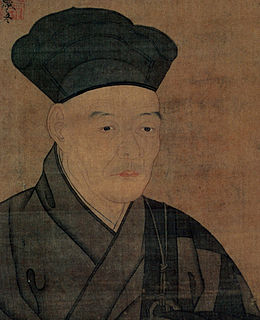
Sesshū Tōyō was the most prominent Japanese master of ink and wash painting from the middle Muromachi period. He was born into the samurai Oda family (小田家), before being brought up and educated to become a Rinzai Zen Buddhist priest. However, early in life he displayed a talent for visual arts, and eventually became one of the greatest Japanese artists of his time, widely revered throughout Japan.

The Town of Gawler is a local government area located north of Adelaide city centre in South Australia containing Gawler and its suburbs. The corporate town was established in 1857 due to the township's residents' dissatisfaction at being governed by three different district councils.

The Adelaide Park Lands are the figure-eight of land spanning both banks of the River Torrens between Hackney and Thebarton and separating the City of Adelaide area from the surrounding suburbia of greater metropolitan Adelaide, the capital city of South Australia. They were laid out by Colonel William Light in his design for the city, and originally consisted of 2,300 acres (930 ha) "exclusive of 32 acres (13 ha) for a public cemetery". One copy of Light's plan shows areas for a cemetery and a Post and Telegraph Store on West Tce, a small Government Domain and Barracks on the central part of North Tce, a hospital on East Tce, a Botanical Garden on the River Torrens west of North Adelaide, and a school and a storehouse south-west of North Adelaide.
The Pioneer Women's Memorial Garden in Park 12 of the Park Lands of Adelaide, South Australia, is a tribute to the pioneer women of South Australia. The garden was designed by landscape designer Elsie Cornish (1887-1946), and the statue created by Ola Cohn was unveiled by Lady Muriel Barclay-Harvey on 19 April 1941.
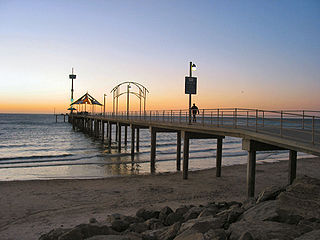
Brighton is a coastal suburb of Adelaide, South Australia, situated between Seacliff and Glenelg and aside Holdfast Bay. Some notable features of the area are the Brighton-Seacliff Yacht Club, the Brighton Surf Lifesaving Club, the Brighton Jetty, and a beach. The Windsor Theatre constructed in 1925 is a long-standing institution, showing cinema to the locals usually two films per night.
Seacliff Park is a suburb of Adelaide partly in the City of Marion and the City of Holdfast Bay. The suburb is adjacent to South Brighton in the north, Seaview Downs to the east, Hallett Cove to the south, and Marino and Seacliff on its western side. The suburb is divided diagonally by Ocean Road, with the northern part of the suburb mainly residential, and the southern park partly occupied by a golf course and a quarry.

The City of Charles Sturt is a local government area in the western suburbs of Adelaide, South Australia, stretching to the coast.
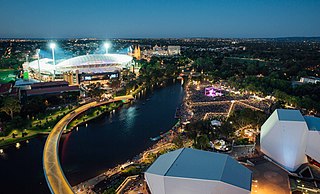
The City of Adelaide, also known as the Corporation of the City of Adelaide and Adelaide City Council is a local government area in the metropolitan area of greater Adelaide, South Australia and is legally defined as the capital city of South Australia by the City of Adelaide Act 1998. It includes the Adelaide city centre, North Adelaide, and the Adelaide Park Lands, which surround North Adelaide and the city centre.
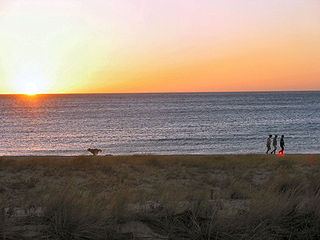
Seacliff is a coastal suburb located in the capital city of South Australia; Adelaide. Overseen by the council, City of Holdfast Bay, this suburb is adjacent to South Brighton, Seacliff Park, Marino and Kingston Park.

Rymill Park / Murlawirrapurka, and numbered as Park 14, is a recreation park located in the East Park Lands of the South Australian capital of Adelaide. There is an artificial lake with rowboats for hire, a café, children's playground and rose garden, and the Adelaide Bowling Club is on the Dequetteville Terrace side. The Adelaide O-Bahn passes underneath it, to emerge at the western side opposite Grenfell Street.

Borrowed scenery is the principle of "incorporating background landscape into the composition of a garden" found in traditional East Asian garden design. The term borrowing of scenery ("shakkei") is Chinese in origin, and appears in the 17th century garden treatise Yuanye.

The Himeji City Tegarayama Botanical Garden, also known as the Himeji Tegarayama Green House, is a botanical garden located within a greenhouse in Tegarayama Central Park at 93 Tegara, Himeji, Hyogo, Japan.

The Japanese Friendship Garden is a Japanese stroll garden located in Phoenix, Arizona. The garden encompasses 3.5 acres (14,000 m2) and includes a tea garden and tea house. It is a joint project of the sister cities of Phoenix, Arizona, and Himeji, Japan. The Japanese name is Rohō-en (鷺鳳園).



















